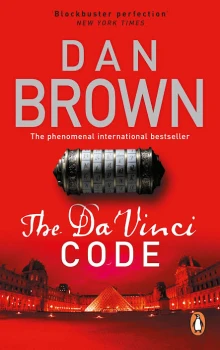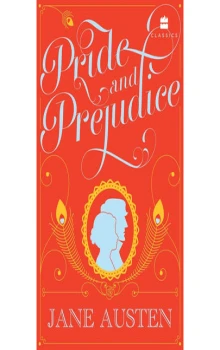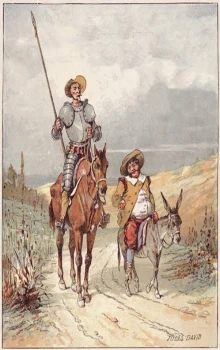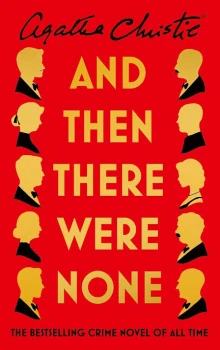Emerging from the shadows, Langdon and Sophie moved stealthily up the deserted
Grand Gallery corridor toward the emergency exit stairwell.
As he moved, Langdon felt like he was trying to assemble a jigsaw puzzle in the dark.
The newest aspect of this mystery was a deeply troubling one: The captain of the Judicial
Police is trying to frame me for murder.
“Do you think,” he whispered, “that maybe Fache wrote that message on the floor?”
Sophie didn't even turn. “Impossible.”
Langdon wasn't so sure. “He seems pretty intent on making me look guilty. Maybe he
thought writing my name on the floor would help his case?”
“The Fibonacci sequence? The P.S.? All the Da Vinci and goddess symbolism? That
had to be my grandfather.”
Langdon knew she was right. The symbolism of the clues meshed too perfectly—the
pentacle, The Vitruvian Man, Da Vinci, the goddess, and even the Fibonacci sequence. A
coherent symbolic set, as iconographers would call it. All inextricably tied.
“And his phone call to me this afternoon,” Sophie added. “He said he had to tell me
something. I'm certain his message at the Louvre was his final effort to tell me something
important, something he thought you could help me understand.”
Langdon frowned. O, Draconian devil! Oh, lame saint! He wished he could
comprehend the message, both for Sophie's well-being and for his own. Things had
definitely gotten worse since he first laid eyes on the cryptic words. His fake leap out the
bathroom window was not going to help Langdon's popularity with Fache one bit.
Somehow he doubted the captain of the French police would see the humor in chasing
down and arresting a bar of soap.
“The doorway isn't much farther,” Sophie said.
“Do you think there's a possibility that the numbers in your grandfather's message hold
the key to understanding the other lines?” Langdon had once worked on a series of
Baconian manuscripts that contained epigraphical ciphers in which certain lines of code
were clues as to how to decipher the other lines.
“I've been thinking about the numbers all night. Sums, quotients, products. I don't see
anything. Mathematically, they're arranged at random. Cryptographic gibberish.”
“And yet they're all part of the Fibonacci sequence. That can't be coincidence.”
“It's not. Using Fibonacci numbers was my grandfather's way of waving another flag
at me—like writing the message in English, or arranging himself like my favorite piece of
art, or drawing a pentacle on himself. All of it was to catch my attention.”
“The pentacle has meaning to you?”
“Yes. I didn't get a chance to tell you, but the pentacle was a special symbol between
my grandfather and me when I was growing up. We used to play Tarot cards for fun,
and my indicator card always turned out to be from the suit of pentacles. I'm sure he
stacked the deck, but pentacles got to be our little joke.”
Langdon felt a chill. They played Tarot? The medieval Italian card game was so replete
with hidden heretical symbolism that Langdon had dedicated an entire chapter in his new
manuscript to the Tarot. The game's twenty-two cards bore names like The Female Pope,
The Empress, and The Star. Originally, Tarot had been devised as a secret means to pass
along ideologies banned by the Church. Now, Tarot's mystical qualities were passed on
by modern fortune-tellers.
The Tarot indicator suit for feminine divinity is pentacles, Langdon thought, realizing
that if Saunière had been stacking his granddaughter's deck for fun, pentacles was an
apropos inside joke.
They arrived at the emergency stairwell, and Sophie carefully pulled open the door. No
alarm sounded. Only the doors to the outside were wired. Sophie led Langdon down a
tight set of switchback stairs toward the ground level, picking up speed as they went.
“Your grandfather,” Langdon said, hurrying behind her, “when he told you about the
pentacle, did he mention goddess worship or any resentment of the Catholic Church?”
Sophie shook her head. “I was more interested in the mathematics of it—the Divine
Proportion, PHI, Fibonacci sequences, that sort of thing.”
Langdon was surprised. “Your grandfather taught you about the number PHI?”
“Of course. The Divine Proportion.” Her expression turned sheepish. “In fact, he used
to joke that I was half divine . . . you know, because of the letters in my name.”
Langdon considered it a moment and then groaned.
s-o-PHI-e.
Still descending, Langdon refocused on PHI. He was starting to realize that Saunière's
clues were even more consistent than he had first imagined.
Da Vinci . . . Fibonacci numbers . . . the pentacle.
Incredibly, all of these things were connected by a single concept so fundamental to art
history that Langdon often spent several class periods on the topic.
PHI.
He felt himself suddenly reeling back to Harvard, standing in front of his “Symbolism
in Art” class, writing his favorite number on the chalkboard.
1.618
Langdon turned to face his sea of eager students. “Who can tell me what this number
is?”
A long-legged math major in back raised his hand. “That's the number PHI.” He
pronounced it fee.
“Nice job, Stettner,” Langdon said. “Everyone, meet PHI.”
“Not to be confused with PI,” Stettner added, grinning. “As we mathematicians like to
say: PHI is one H of a lot cooler than PI!”
Langdon laughed, but nobody else seemed to get the joke.
Stettner slumped.
“This number PHI,” Langdon continued, “one-point-six-one-eight, is a very important
number in art. Who can tell me why?”
Stettner tried to redeem himself. “Because it's so pretty?”
Everyone laughed.
“Actually,” Langdon said, “Stettner's right again. PHI is generally considered the most
beautiful number in the universe.”
The laughter abruptly stopped, and Stettner gloated.
As Langdon loaded his slide projector, he explained that the number PHI was derived
from the Fibonacci sequence—a progression famous not only because the sum of
adjacent terms equaled the next term, but because the quotients of adjacent terms
possessed the astonishing property of approaching the number 1.618—PHI!
Despite PHI's seemingly mystical mathematical origins, Langdon explained, the truly
mind-boggling aspect of PHI was its role as a fundamental building block in nature.
Plants, animals, and even human beings all possessed dimensional properties that adhered
with eerie exactitude to the ratio of PHI to 1.
“PHI's ubiquity in nature,” Langdon said, killing the lights, “clearly exceeds
coincidence, and so the ancients assumed the number PHI must have been preordained
by the Creator of the universe. Early scientists heralded one-point-six-one-eight as the
Divine Proportion.”
“Hold on,” said a young woman in the front row. “I'm a bio major and I've never seen
this Divine Proportion in nature.”
“No?” Langdon grinned. “Ever study the relationship between females and males in a
honeybee community?”
“Sure. The female bees always outnumber the male bees.”
“Correct. And did you know that if you divide the number of female bees by the
number of male bees in any beehive in the world, you always get the same number?”
“You do?”
“Yup. PHI.”
The girl gaped. “NO WAY!”
“Way!” Langdon fired back, smiling as he projected a slide of a spiral seashell.
“Recognize this?”
“It's a nautilus,” the bio major said. “A cephalopod mollusk that pumps gas into its
chambered shell to adjust its buoyancy.”
“Correct. And can you guess what the ratio is of each spiral's diameter to the next?”
The girl looked uncertain as she eyed the concentric arcs of the nautilus spiral.
Langdon nodded. “PHI. The Divine Proportion. One-point-six-one-eight to one.”
The girl looked amazed.
Langdon advanced to the next slide—a close-up of a sunflower's seed head.
“Sunflower seeds grow in opposing spirals. Can you guess the ratio of each rotation's
diameter to the next?”
“PHI?” everyone said.
“Bingo.” Langdon began racing through slides now—spiraled pinecone petals, leaf
arrangement on plant stalks, insect segmentation—all displaying astonishing obedience to
the Divine Proportion.
“This is amazing!” someone cried out.
“Yeah,” someone else said, “but what does it have to do with art?”
“Aha!” Langdon said. “Glad you asked.” He pulled up another slide—a pale yellow
parchment displaying Leonardo da Vinci's famous male nude—The Vitruvian Man—
named for Marcus Vitruvius, the brilliant Roman architect who praised the Divine
Proportion in his text De Architectura.
“Nobody understood better than Da Vinci the divine structure of the human body. Da
Vinci actually exhumed corpses to measure the exact proportions of human bone
structure. He was the first to show that the human body is literally made of building
blocks whose proportional ratios always equal PHI.”
Everyone in class gave him a dubious look.
“Don't believe me?” Langdon challenged. “Next time you're in the shower, take a tape
measure.”
A couple of football players snickered.
“Not just you insecure jocks,” Langdon prompted. “All of you. Guys and girls. Try it.
Measure the distance from the tip of your head to the floor. Then divide that by the
distance from your belly button to the floor. Guess what number you get.”
“Not PHI!” one of the jocks blurted out in disbelief.
“Yes, PHI,” Langdon replied. “One-point-six-one-eight. Want another example?
Measure the distance from your shoulder to your fingertips, and then divide it by the
distance from your elbow to your fingertips. PHI again. Another? Hip to floor divided
by knee to floor. PHI again. Finger joints. Toes. Spinal divisions. PHI. PHI. PHI. My
friends, each of you is a walking tribute to the Divine Proportion.”
Even in the darkness, Langdon could see they were all astounded. He felt a familiar
warmth inside. This is why he taught. “My friends, as you can see, the chaos of the world
has an underlying order. When the ancients discovered PHI, they were certain they had
stumbled across God's building block for the world, and they worshipped Nature because
of that. And one can understand why. God's hand is evident in Nature, and even to this
day there exist pagan, Mother Earth–revering religions. Many of us celebrate nature the
way the pagans did, and don't even know it. May Day is a perfect example, the
celebration of spring . . . the earth coming back to life to produce her bounty. The
mysterious magic inherent in the Divine Proportion was written at the beginning of time.
Man is simply playing by Nature's rules, and because art is man's attempt to imitate the
beauty of the Creator's hand, you can imagine we might be seeing a lot of instances of the
Divine Proportion in art this semester.”
Over the next half hour, Langdon showed them slides of artwork by Michelangelo,
Albrecht Dürer, Da Vinci, and many others, demonstrating each artist's intentional and
rigorous adherence to the Divine Proportion in the layout of his compositions. Langdon
unveiled PHI in the architectural dimensions of the Greek Parthenon, the pyramids of
Egypt, and even the United Nations Building in New York. PHI appeared in the
organizational structures of Mozart's sonatas, Beethoven's Fifth Symphony, as well as the
works of Bartók, Debussy, and Schubert. The number PHI, Langdon told them, was
even used by Stradivarius to calculate the exact placement of the f-holes in the
construction of his famous violins.
“In closing,” Langdon said, walking to the chalkboard, “we return to symbols.” He
drew five intersecting lines that formed a five-pointed star. “This symbol is one of the
most powerful images you will see this term. Formally known as a pentagram—or
pentacle, as the ancients called it—this symbol is considered both divine and magical by
many cultures. Can anyone tell me why that might be?”
Stettner, the math major, raised his hand. “Because if you draw a pentagram, the lines
automatically divide themselves into segments according to the Divine Proportion.”
Langdon gave the kid a proud nod. “Nice job. Yes, the ratios of line segments in a
pentacle all equal PHI, making this symbol the ultimate expression of the Divine
Proportion. For this reason, the five-pointed star has always been the symbol for beauty
and perfection associated with the goddess and the sacred feminine.”
The girls in class beamed.
“One note, folks. We've only touched on Da Vinci today, but we'll be seeing a lot more
of him this semester. Leonardo was a well-documented devotee of the ancient ways of
the goddess. Tomorrow, I'll show you his fresco The Last Supper, which is one of the
most astonishing tributes to the sacred feminine you will ever see.”
“You're kidding, right?” somebody said. “I thought The Last Supper was about Jesus!”
Langdon winked. “There are symbols hidden in places you would never imagine.”
“Come on,” Sophie whispered. “What's wrong? We're almost there. Hurry!”
Langdon glanced up, feeling himself return from faraway thoughts. He realized he was
standing at a dead stop on the stairs, paralyzed by sudden revelation.
O, Draconian devil! Oh, lame saint!
Sophie was looking back at him.
It can't be that simple, Langdon thought.
But he knew of course that it was.
There in the bowels of the Louvre . . . with images of PHI and Da Vinci swirling
through his mind, Robert Langdon suddenly and unexpectedly deciphered Saunière's
code.
“O, Draconian devil!” he said. “Oh, lame saint! It's the simplest kind of code!”
Sophie was stopped on the stairs below him, staring up in confusion. A code? She had
been pondering the words all night and had not seen a code. Especially a simple one.
“You said it yourself.” Langdon's voice reverberated with excitement. “Fibonacci
numbers only have meaning in their proper order. Otherwise they're mathematical
gibberish.”
Sophie had no idea what he was talking about. The Fibonacci numbers? She was
certain they had been intended as nothing more than a means to get the Cryptography
Department involved tonight. They have another purpose? She plunged her hand into
her pocket and pulled out the printout, studying her grandfather's message again.
13-3-2-21-1-1-8-5
O, Draconian devil!
Oh, lame saint!
What about the numbers?
“The scrambled Fibonacci sequence is a clue,” Langdon said, taking the printout. “The
numbers are a hint as to how to decipher the rest of the message. He wrote the sequence
out of order to tell us to apply the same concept to the text. O, Draconian devil? Oh, lame
saint? Those lines mean nothing. They are simply letters written out of order.”
Sophie needed only an instant to process Langdon's implication, and it seemed
laughably simple. “You think this message is . . . une anagramme?” She stared at him.
“Like a word jumble from a newspaper?”
Langdon could see the skepticism on Sophie's face and certainly understood. Few
people realized that anagrams, despite being a trite modern amusement, had a rich history
of sacred symbolism.
The mystical teachings of the Kabbala drew heavily on anagrams—rearranging the
letters of Hebrew words to derive new meanings. French kings throughout the
Renaissance were so convinced that anagrams held magic power that they appointed
royal anagrammatists to help them make better decisions by analyzing words in important
documents. The Romans actually referred to the study of anagrams as ars magna—“the
great art.”
Langdon looked up at Sophie, locking eyes with her now. “Your grandfather's
meaning was right in front of us all along, and he left us more than enough clues to see
it.”
Without another word, Langdon pulled a pen from his jacket pocket and rearranged
the letters in each line.
O, Draconian devil!
Oh, lame saint!
was a perfect anagram of . . .
Leonardo da Vinci!
The Mona Lisa!





